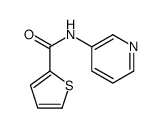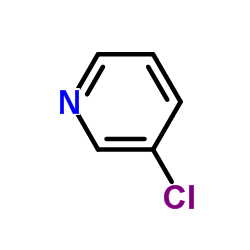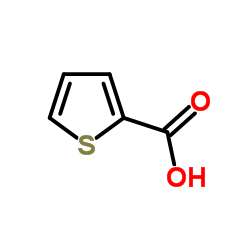62289-81-0
| Name | N-pyridin-3-ylthiophene-2-carboxamide |
|---|---|
| Synonyms |
N-(3-pyridinyl)-2-thiophenecarboxamide
thiophene-2-carboxylic acid pyridin-3-ylamide SW-106065 |
| Description | SW106065 is an apoptosis inducer in malignant peripheral nerve sheath tumors (MPNST). SW106065 inhibits ATP consumption of sMPNST and other models of MPNST with an EC50 of 1 µM. SW106065 can be used for MPNST research[1]. |
|---|---|
| Related Catalog | |
| In Vitro | SW106065 (Compound 21, Cpd21) inhibits the human MPNST cell lines growth in a dose-dependent manner, and EC50 concentrations of 439 nM and 753.6 nM for S462 and SNF96.2 cells, respectively. SW106065 remains nontoxic to normally dividing Schwann cells or mouse embryonic fibroblasts[1]. SW106065 (Cpd21; 0.25-5 µM; 24 hours; sMPNST cells) treatment shows a decreased percentage of cells in S phase, and a corresponding increased percentage in G1/G0 and G2/M[1]. SW106065 (Cpd21; 0.25-5 µM; 24 hours; sMPNST cells) treatment decreases the levels of cyclin A2, cyclin B1, cyclin D1, cyclin E, cdk4, and cdk6. And increases levels of cdkn1a and cdkn2a mRNA were observed in a dose-dependent manner.SW106065 (Cpd21; 0.25-5 µM; 24 hours; sMPNST cells) treatment decreases the levels of Cyclin D1 protein[1]. SW106065 (Cpd21) treatment significant increase in the percentage of apoptotic cells[1]. Cell Cycle Analysis[1] Cell Line: sMPNST cells Concentration: 0.25 µM, 0.5 µM, 1 µM, 2.5 µM, and 5 µM Incubation Time: 24 hours Result: Showed a decreased percentage of cells in S phase, and a corresponding increased percentage in G1/G0 and G2/M. RT-PCR[1] Cell Line: sMPNST cells Concentration: 0.25 µM, 0.5 µM, 1 µM, 2.5 µM, and 5 µM Incubation Time: 24 hours Result: Decreased levels of cyclin A2, cyclin B1, cyclin D1, cyclin E, cdk4, and cdk6. Increased levels of cdkn1a and cdkn2a mRNA were observed in a dose-dependent manner. Western Blot Analysis[1] Cell Line: sMPNST cells Concentration: 0.25 µM, 0.5 µM, 1 µM, 2.5 µM, and 5 µM Incubation Time: 24 hours Result: Decreased levels of Cyclin D1 protein. |
| In Vivo | SW106065 (Cpd21; 40 mg/kg; intraperitoneal injection; twice per day for 4 weeks) treatment can be delivered to mice in concentrations to sufficiently penetrate sMPNST tissue, and inhibit tumor development[1]. Animal Model: NCR-nu/nu female mice (6-7 week old) injected with MPNST cells[1] Dosage: 40 mg/kg Administration: Intraperitoneal injection; twice per day for 4 weeks Result: Reduced MPNST burden in a mouse allograft model. |
| References |
| Molecular Formula | C10H8N2OS |
|---|---|
| Molecular Weight | 204.24800 |
| Exact Mass | 204.03600 |
| PSA | 70.23000 |
| LogP | 2.46840 |
|
~93% 
62289-81-0 |
| Literature: Ikawa, Takashi; Barder, Timothy E.; Biscoe, Mark R.; Buchwald, Stephen L. Journal of the American Chemical Society, 2007 , vol. 129, # 43 p. 13001 - 13007 |
|
~% 
62289-81-0 |
| Literature: Zhang, Jianmin; Pettersson, Hanna I.; Huitema, Carly; Niu, Chunying; Yin, Jiang; James, Michael N. G.; Eltis, Lindsay D.; Vederas, John C. Journal of Medicinal Chemistry, 2007 , vol. 50, # 8 p. 1850 - 1864 |
|
~% 
62289-81-0 |
| Literature: Zhang, Jianmin; Pettersson, Hanna I.; Huitema, Carly; Niu, Chunying; Yin, Jiang; James, Michael N. G.; Eltis, Lindsay D.; Vederas, John C. Journal of Medicinal Chemistry, 2007 , vol. 50, # 8 p. 1850 - 1864 |




